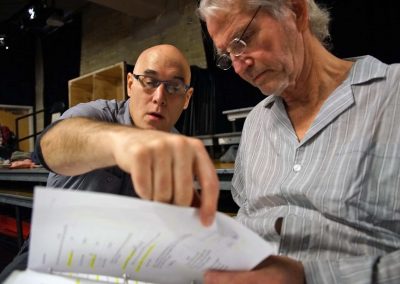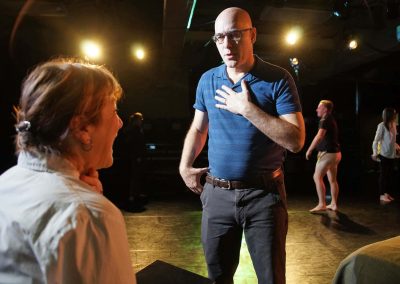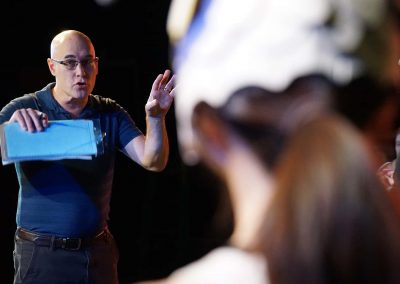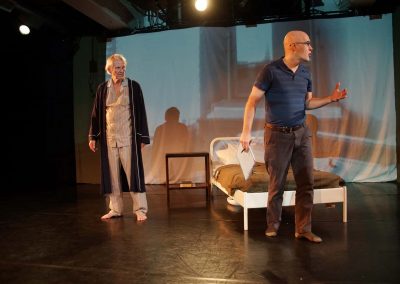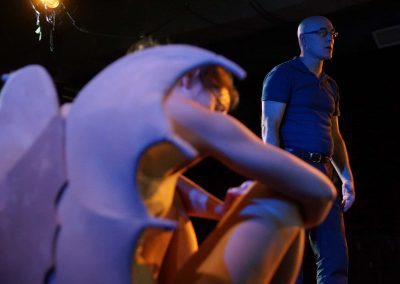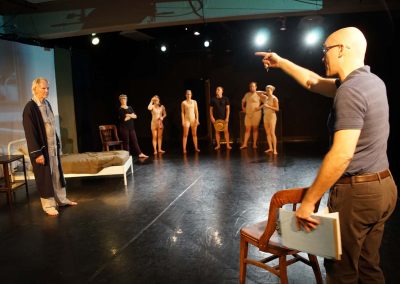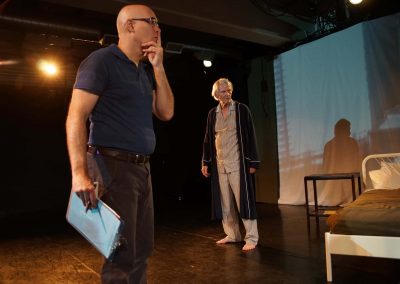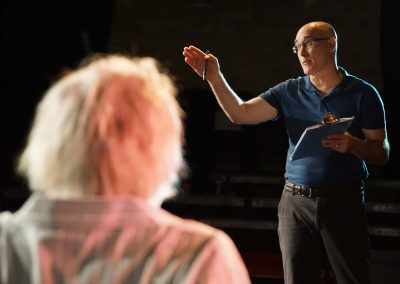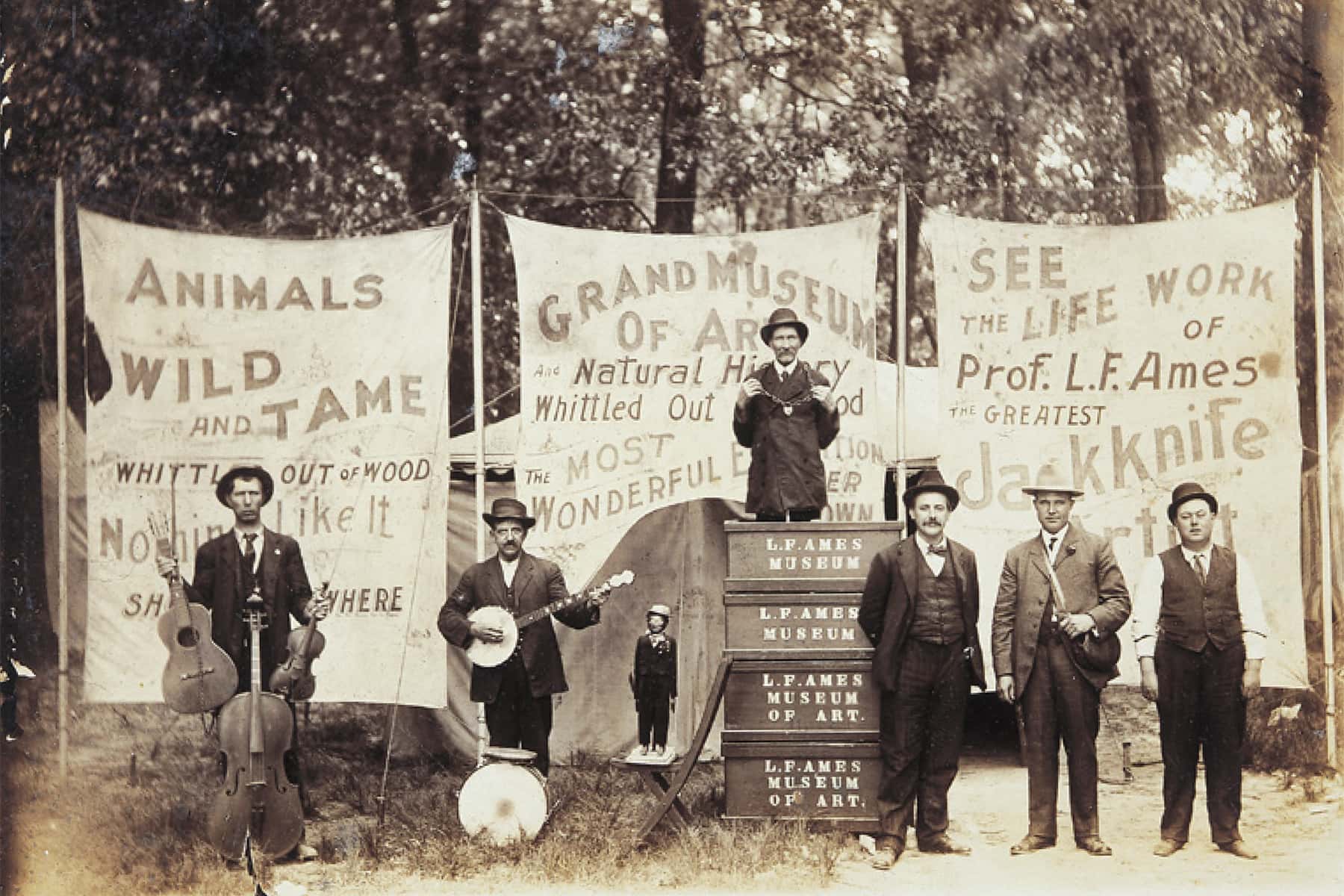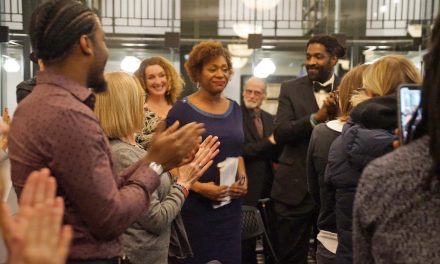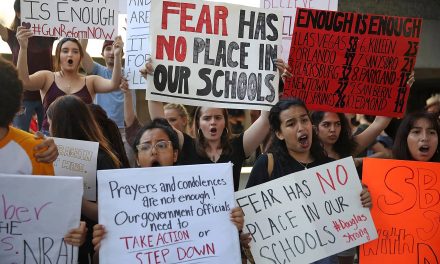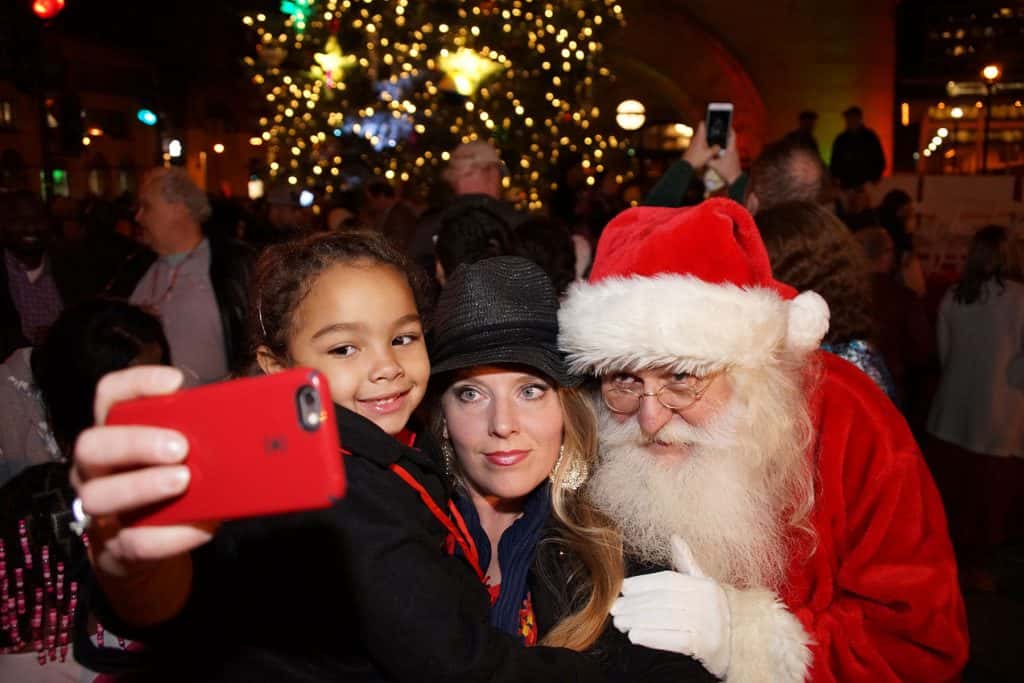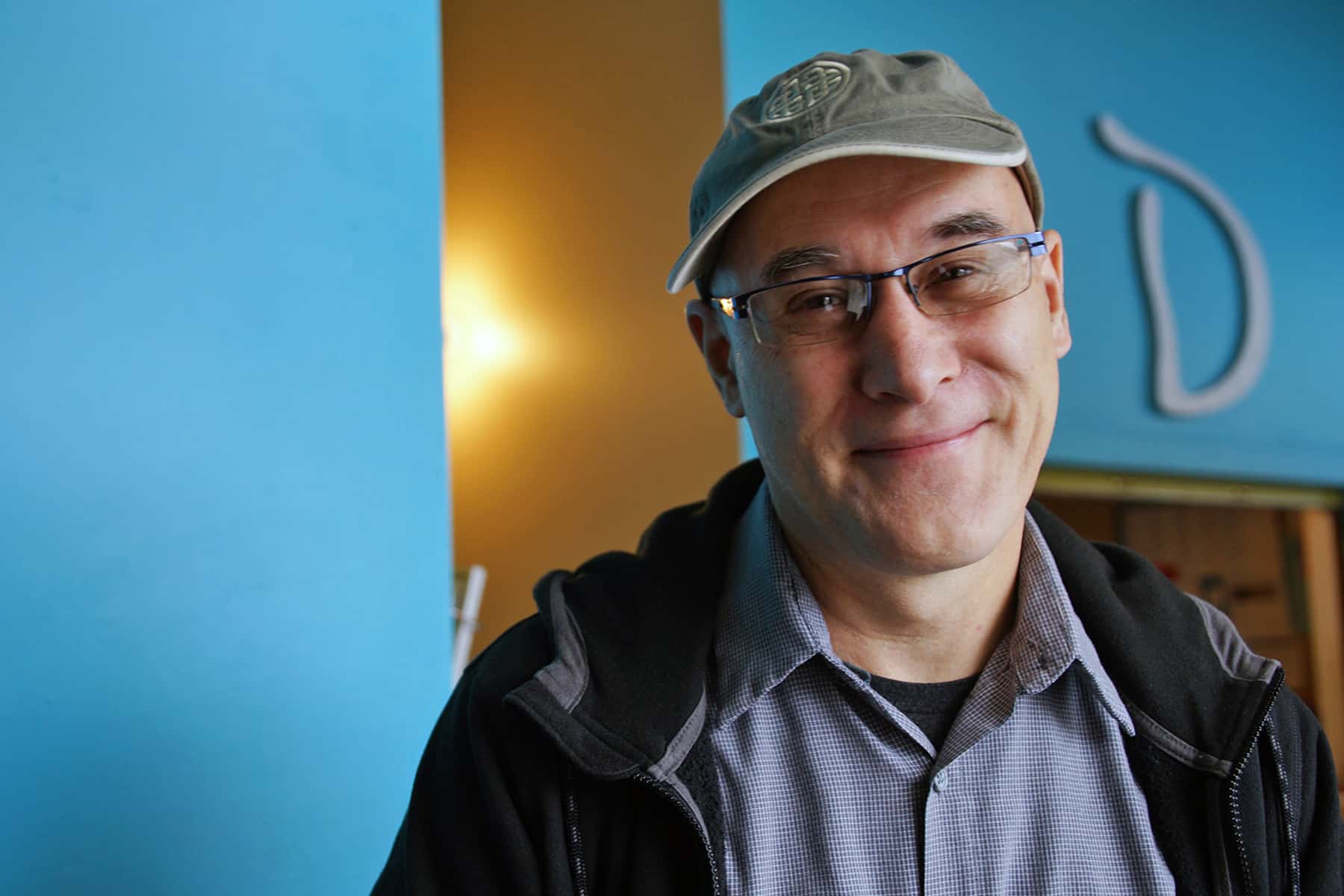
As an award-winning director and playwright with numerous production credits in Milwaukee, Edward Morgan has worked at regional theaters, Shakespeare festivals, and universities across North and South America.
His latest project with Danceworks combines his love of history and the arts with the original presentation of “Against the Grain: The Life & Times of Levi Fisher Ames.” The Milwaukee Independent attended several of the play’s rehearsals for a behind-the-scenes look at its creative process, and spoke with Morgan about his life and work.
Q&A with Edward Morgan
Milwaukee Independent: When did your enthusiasm for early United States history develop?
Edward Morgan: Initially, it came through my family stories. I grew up hearing about ancestors in the Revolutionary War and the Civil War (on both sides). It also came through growing up around a lot of traditional southern music and the music connects you to history. Then just being American, I’ve always been curious about what that really means. I wanted to learn about the events that shaped our country, especially early on.
Milwaukee Independent: Did your family connections with the Revolutionary and Civil Wars have an impact on your life?
Edward Morgan: Yes. I grew up with certain beliefs about being Southern and being Celtic and some of those I shed over time and some I didn’t. But those beliefs and the family stories behind them had a powerful effect on me. One example was a spring I spent in Ireland collecting traditional songs and folklore on a grant, in my senior year of college. It was an academic pursuit but it was also a personal pilgrimage. Through three months in Ireland I discovered more of both what I am and what I’m not. I’m not Irish, though I had a lot of Irish and Scottish ancestors, and I felt like I connected with Ireland in a very real way on that trip. But I also really realized how American I am, and choose to be.
Another example is just how much my grandfather influenced me. First of all I’m named after him. More importantly, he was a Minister, a professor of Greek and Hebrew and Head of the New Testament Department at the Baptist Theological Seminary in Louisville – until the Fundamentalists took over the denomination, and that’s when he resigned. He was also active in Civil Rights. In his first ministerial post, he was in conflict with the Klu Klux Klan. They burned a cross in his yard and the church quickly transferred him. Later on, he was among the ministers (initially both white and black) involved in the early stages of planning what became the Southern Christian Leadership Council. So he’d worked with Martin Luther King, Sr. He was in many ways a role model for me.
Milwaukee Independent: What lessons do you think Americans still have not learned from the Civil War?
Edward Morgan: Volumes have been written on this by folks with a lot more knowledge of history and politics than me. But it’s pretty clear that we’re still living partly in the shadow of that war. Look at the recent strife over Confederate monuments. Or look at the statistical imbalances in our justice system, the inequities of economics and education, the ongoing questions about the relationship between police and African Americans. To me it seems like our current culture wars are primarily descended from two eras: slavery days and the Civil War to Reconstruction, and then the Viet Nam War era.
Milwaukee Independent: How were you able to combine your love of history with your love of theater?
Edward Morgan: I’ve done a lot of that! First of all, I’ve directed a lot of American plays that have drawn on my knowledge and love of history. Here in Milwaukee, my first gig was arranging music for a play set in Appalachia in the 1920’s. That was at Milwaukee Rep. In later years at the Rep, I adapted Ibsen’s Ghosts and set it in South Carolina during Reconstruction. I wrote and directed a post-modern adaptation of Huckleberry Finn called “Sounding the River.” I adapted “Benito Cereno” – the story of a rebellion on a slave ship – and joined with Ko-Thi African Dance Company to give an African dimension to that story. This was before the movie “Amistad,” by the way. After leaving the Rep, I joined up with John Kishline and we wrote “A Rising Wind” about the Lady Elgin sinking in 1860. That was produced a few places and taped and broadcast for Milwaukee Public TV. Kishline and I also wrote “UnSilent Night,” which took place in the 1950’s, and that was mounted at Next Act Theatre two years ago. I adapted a Faulkner novel set during the flood of 1927 and that play, “Way Downriver,” has had productions in Alabama and California. I also recently finished a play about immigration and the eugenics movement which is set in NY in 1932. That play hasn’t been produced yet. And how there’s “Against the Grain,” which takes place in Madison in 1923. So that kind of thing has been a lot of my career.
Milwaukee Independent: Looking back at your play “Rising Wind; The Lady Elgin Story,” what are you most proud of about the production?
Edward Morgan: I think we found a great angle on that story. First of all, we had four individual voices, each telling the tale from their unique point of view. Plus a fifth character who kind of sets it up. But in terms of the big picture, I think we managed to ground the era’s historical conflicts and ideas to the battle of wills between two men: Governor Randall and the Irish Militia Captain Garret Barry. And then, we focused on their collision as a metaphor for the collision of those two ships out on Lake Michigan. In other words, I think we gave the story a personal and a historical context and tied them together.
Milwaukee Independent: Where did the idea come from for your current work, “Against the Grain?”
Edward Morgan: In about 2006, I helped John McGivern create a show that we called “A Midsummer Night McGivern.” In August of 2007, we took it up to the J. M. Kohler Arts Center in Sheboygan for a week of performances. That’s where I saw the exhibit of Levi Fisher Ames’ carvings and read a two page essay about Ames’ work and his life story by Leslie Umberger, the curator of the exhibit. And it just spoke to me.
I’ve always loved Folk Art – now they call it Outsider Art. I spent time in Appalachia growing up, my undergrad degree was in Oral Tradition and I collected folklore in Ireland and Brittany. So Ames’ carvings spoke to me immediately on that level. They’re raw, direct, fun and totally unpretentious. They’re theatrical too, the way he presented them in little shadow boxes, and sometimes they tell a kind of story with animals fighting or interacting in some way. And some of the animals are realistic and some are mythological.
But it was the combination of Levi’s carvings and his life story that really grabbed me. Here’s a guy who comes home damaged from war. He can’t work like he used to but he just begins to carve, he teaches himself and just starts creating. And pretty soon it takes over his life. He’s researching animals, he’s photographing them, he’s constantly carving out in his yard and the kids in his neighborhood are coming around him and he’s teaching them and telling them stories. And then his vision expands again and he creates this amazing new life for himself as a 19th century showman with a traveling tent.
He drags his whole family into it, too. But through it all, he stays true to his own artistic sense and his belief in his work. He won’t sell any of his carvings and he’s determined that his collection stay together after he dies. Time has proven him right, in the sense that he’s really somebody in the world of Outsider Art. His work is one of the more important collections at the Kohler museum. It’s been written about, it’s toured internationally. His legacy is secure.
And I think I had the idea for this show the same day I saw the exhibit. It just came to me as a story that could be told with theatre and dance. Only it took me 11 years to get around to it. Ultimately, I love Levi’s story, because even though it’s historical, it touches so many themes I can relate to. Themes about healing and the power of creativity and our ability to reinvent ourselves. And then of course, our play is also about saying goodbye because he’s letting go, he’s dying. It really brings a lot of themes together.
Milwaukee Independent: What is the most curious discovery you made while researching Levi Fisher Ames?
Edward Morgan: There isn’t a lot to research about his life. The Kohler put out a booklet with some great photos of his work, but it was mostly focused on his art and the cultural context. There’s also a chapter about Ames in a book Leslie Umberger edited about Outsider Artists, but it largely covered the same ground with more detail. There were also a few notes on file at the Kohler from interviews with Ames’ grandson, Howard Jordan, who saved the collection for nearly 70 years before donating it to the Kohler Foundation. But I didn’t find a lot more, and we didn’t need a lot more, really. We had enough information about his life to be write a fictional story that was historically based. Of course, it helped that in other contexts I’ve researched the Civil War, the period in which Ames lived, and the entertainment of that era. But I did dig up some actual old Vaudeville routines, and stole some lines from one of them.
Milwaukee Independent: How does the use of poetry help you tell stories on stage?
Edward Morgan: We’re telling our story with acting, dance, and film. We’re also exploring different ways that they overlap. So a couple of times Levi speak with heightened language – a kind of poetry – when the movement is also heightened into dance. I think it works well.
Milwaukee Independent: What has the process been like to combine so many art forms into a single live performance?
Edward Morgan: So far it’s been really fun and really fresh as a process. Dani Kuepper (the choreographer) and I have had an easy collaboration, both conceptually and in rehearsal. But dancers and actors rehearse differently, so it’s a fresh mix. Also, we’re still in the process of discovering what we’ve got. Dani’s worked before with Kym McDaniel, our filmmaker, but I haven’t. I’ve only seen her work in a previous show. But we’re both eagerly awaiting our first looks at her contributions. We’ve also got sculptural costume pieces coming, designed by Lyn Kream, to help transform our dancers into animals. We’ve seen phots of some of those, and they’re exciting. Overall, I have to say, it’s great to work outside of my usual frame of reference as a director of straight plays.
Milwaukee Independent: What do you hope audiences take away from your plays, particularly your latest work?
Edward Morgan: It’s tough to generalize, but I always hope my theatre work creates a vivid, worthwhile experience. As a director, I try to cast a spell of sorts that takes people on a journey and gives them an authentic experience, be it emotional or funny or idea-centered. It’s not much different as a writer, really. I don’t try to tell people what to think or feel and I don’t like to be preached to or emotionally manipulated. So I hope I help tell stories that touch people and relate to their life experiences and yet seem new. And sometimes I hope to provoke, but again, I’d rather raise questions rather than answer them.
As for this particular piece, we’re aiming for an integration of theatre, dance and film that’s really unusual, where each art form plays an essential storytelling role. It’s not a play with some dances or a dance with some text here and there. There are some events that can only be told by dance and others need language and realistic behavior. Meanwhile, the film is a window into Levi’s mind. Sometimes it grounds us as to where he thinks we are; sometimes it’s as if we’re seeing his creative process. And the film will also connect the dancers to the actual carvings, in our minds. But really, at this point, we don’t know yet how it’s all going to come together because we’re all on new ground. And that’s part of what makes it such an exciting collaboration.
I want people to be moved by the story. I want them to laugh and be touched and I want them to be wowed at points by all of these artistic mediums intersecting in one story. It’s also kind of a tour, if you will, through old Wisconsin. I think it’s going to be special. As you can tell, I’m passionate about it.
Milwaukee Independent: Do you have a dream historical project that you want to produce? And what will be your next Milwaukee-based play?
Edward Morgan: This project was one of those dream projects, given that’s it’s been in my brain for 11 years. But I have a handful of them. There are a couple of novels I want to adapt. And I’ve recently written a play about events that happened in the Dominican Republic in 1960 in the waning days of the dictator Trujillo. It took me 3 years to write and I’m now working on getting it produced there, in Spanish. So that’s my current dream project, after this one.
I’m not sure what my next Milwaukee-based play will be, but it’s almost certain to say that it will be at Next Act Theatre. David Cecsarini, the Artistic Director there, brings me back to direct for him pretty regularly. That’s my artistic home in Milwaukee.
Milwaukee Independent: What advice would you offer to the youth of Milwaukee about pursuing their dreams to work in live theater?
Edward Morgan: I have two thoughts about that. First, I believe in training and getting a professional grounding for one’s work. On the other hand, I say: just do it. I’ve learned an awful lot by just taking the initiative and doing things, and if you wait until you really feel you’re ready or have the money or the right space or somebody’s permission – well, then it may never happen. So I’m for taking a flying leap when you can. This project is definitely one of those leaps.

